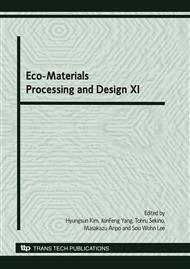p.384
p.388
p.392
p.396
p.400
p.404
p.408
p.412
p.416
Synthesis of SiOC Base Fibers from Silicone Resin with Low Carbon Content and Control of Surface Functionality by Metal Chloride Treatment in Vapor
Abstract:
Melt spinnable silicone resin with a low carbon content was spun to fiber form with an averaged diameter of 16.8 m. When the resin fiber was cured by SiCl4 vapor and pyrolyzed at 1273K in inert atmosphere, Si-O-C fiber with smooth surface was obtained. The measured tensile strength was relatively low. The fiber, however, showed oxidation resistance during high temperature exposure under an air flow. When the fiber was cured by TiCl4 with an increased vapor pressure at 313K, 40% mass gain was observed after the curing. SiO2-TiO2 fiber was obtained by pyrolysis in an air flow, while SiOC-TiO2 fiber was obtained by pyrolysis in an inert atmosphere. Structure of TiO2 and the resulting fiber surface morphology strongly depended on the temperature and the atmosphere during the pyrolysis.
Info:
Periodical:
Pages:
400-403
Citation:
Online since:
July 2010
Permissions:
Share:
Citation:


